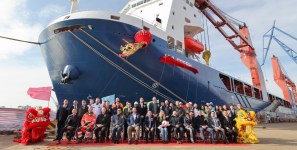What Next for THE Alliance?
The container shipping industry is in a state of flux and nobody can say they know for certain what the landscape will look like in six months from now.
Even before Hanjin Shipping filed for bankruptcy protection the industry was preparing itself for big changes to the major shipping alliances, which from April next year are scheduled to downsize from four to three. But Hanjin’s demise and uncertainty surrounding new membership agreements and regulatory approval have clouded the picture, says a recent report from Drewry.
Hanjin was one of six carriers along with Hapag-Lloyd, K Line, MOL, NYK, and Yang Ming that in May of this year announced they would form THE Alliance to serve the East-West container trades beginning the second-quarter 2017. The South Korean carrier was the second largest of the group with 460,000 TEU in capacity before it exited the stage in August.
To some extent Hanjin has already been replaced. Hapag-Lloyd’s merger with United Arab Shipping Co. (UASC) will add 315,000 TEU, bridging some but not the entire gap. Merger talks between Hapag-Lloyd and UASC were well underway at the time of the announcement and the latter was always expected to become the seventh member. Expectations that there would be an eighth partner were confounded when it emerged that the financially troubled Hyundai Merchant Marine (HMM) was in talks to join the world’s two largest carriers Maersk Line and MSC in the 2M alliance.
Based on the east-west vessel deployment in August, excluding Hanjin but including UASC, THE Alliance market share was around 24 percent, well below that of the 2M + HMM, at 31 percent, and OCEAN Alliance, with 34 percent.
Calculating potential market shares for the three proposed mega-alliances is complicated by the fact that HMM’s deal with the 2M lines is yet to be concluded and that no one knows who will pick up Hanjin’s capacity, which was approximately five percent of east-west ships in August. HMM, which shares the same main creditor in the Korea Development Bank, is a likely buyer of some of the more attractive younger and bigger units in Hanjin’s portfolio of owned ships, according to the Drewry report. (Maersk is reportedly eyeing both HMM and Hanjin as acquisition targets.)
HMM would very much be the junior partner in the 2M /H2M alliance but even so the addition of too much Hanjin capacity could pose competition issues as the existing lines are already at the upper limits of what is acceptable to regulators.
In the U.S., the Federal Maritime Commission (FMC) has requested more information to consider the proposal of the OCEAN Alliance members CMA CGM, Cosco, Evergreen, and OOCL, although there is no suggestion that the move will cancel or even push back the scheduled April start.
Drewry projects that THE Alliance will be far smaller than its two rivals. “It’s potential to upsize by using ships currently outside of the alliance east-west network parameters and with new ships is also far smaller than the other two groups,” the report said.
This raises the question of whether they can swell their numbers with the addition of one or more other carriers. When Drewry asked the major carrier in THE Alliance, Hapag-Lloyd, how they planned to handle the loss of Hanjin there was no indication that it was looking to bring in anyone else.
Surprisingly, in the current era of competitive-cooperation between lines there are still a few non-alliance affiliated carriers that might be targets. The Hamburg Süd Group would bring the most capacity but as a north-south specialist it might want the alliance to broaden its scope before agreeing to join. Zim has thus far been happy to piggy-back on the east-west services of other alliances and has given no indication that it wants to become part of any group. The other Top 20 candidates, PIL and Wan Hai, have only limited exposure to the east-west markets and so might not feel the need to become formal partners.
Drewry advises shippers “to pay more attention to the financial risks when selecting carriers. With so much uncertainty shippers will probably look to hedge their bets with the alliances at the beginning and see which one works best for them in the long-term.”





Leave a Reply